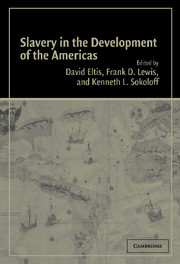Book contents
- Frontmatter
- Contents
- Appreciation: Stanley L. Engerman and Slavery
- Introduction
- PART I ESTABLISHING THE SYSTEM
- PART II PATTERNS OF SLAVE USE
- PART III PRODUCTIVITY CHANGE AND ITS IMPLICATIONS
- 6 Prices of African Slaves Newly Arrived in the Americas, 1673–1865: New Evidence on Long-Run Trends and Regional Differentials
- 7 American Slave Markets During the 1850s: Slave Price Rises in the United States, Cuba, and Brazil in Comparative Perspective
- 8 The Relative Efficiency of Free and Slave Agriculture in the Antebellum United States: A Stochastic Production Frontier Approach
- PART IV IMPLICATIONS FOR DISTRIBUTION AND GROWTH
- The Writings of Stanley L. Engerman
- Contributors
- Index
6 - Prices of African Slaves Newly Arrived in the Americas, 1673–1865: New Evidence on Long-Run Trends and Regional Differentials
Published online by Cambridge University Press: 18 August 2009
- Frontmatter
- Contents
- Appreciation: Stanley L. Engerman and Slavery
- Introduction
- PART I ESTABLISHING THE SYSTEM
- PART II PATTERNS OF SLAVE USE
- PART III PRODUCTIVITY CHANGE AND ITS IMPLICATIONS
- 6 Prices of African Slaves Newly Arrived in the Americas, 1673–1865: New Evidence on Long-Run Trends and Regional Differentials
- 7 American Slave Markets During the 1850s: Slave Price Rises in the United States, Cuba, and Brazil in Comparative Perspective
- 8 The Relative Efficiency of Free and Slave Agriculture in the Antebellum United States: A Stochastic Production Frontier Approach
- PART IV IMPLICATIONS FOR DISTRIBUTION AND GROWTH
- The Writings of Stanley L. Engerman
- Contributors
- Index
Summary
Prices of slaves in the Atlantic slave trade are of central importance to understanding not only the slave trade, but also the larger Atlantic economy in the two centuries after 1660. In the last thirty years, a range of sources have yielded data from sales of slaves for the nineteenth century United States, Cuba, Brazil and Mauritius. Although the status of slaves from which these data are drawn has varied almost as much as the geographic location, the price patterns they have revealed have striking similarities. Apart from Minas Gerais and perhaps Bahia in Brazil, the pre-1800 period is much less well represented. Moreover, even for the nineteenth century, the data have derived from sales of individuals who had lived in the Americas for some time. The one substantial body of data for newly arrived Africans, and, indeed, for the pre-1800 era is for the island of Barbados, between 1673 and 1723. However, recent work on the shipping of slaves from Africa to the Americas, which has culminated in the publication of the Cambridge slave trade CD-ROM, has thrown up a substantial body of new data on prices that cover not only a wide range of regions in the Americas, but also the period when the slave trade rose from quite modest levels in the mid seventeenth century to its peak in the late eighteenth century and the beginning of its slow decline thereafter.
- Type
- Chapter
- Information
- Slavery in the Development of the Americas , pp. 181 - 218Publisher: Cambridge University PressPrint publication year: 2004
- 13
- Cited by

